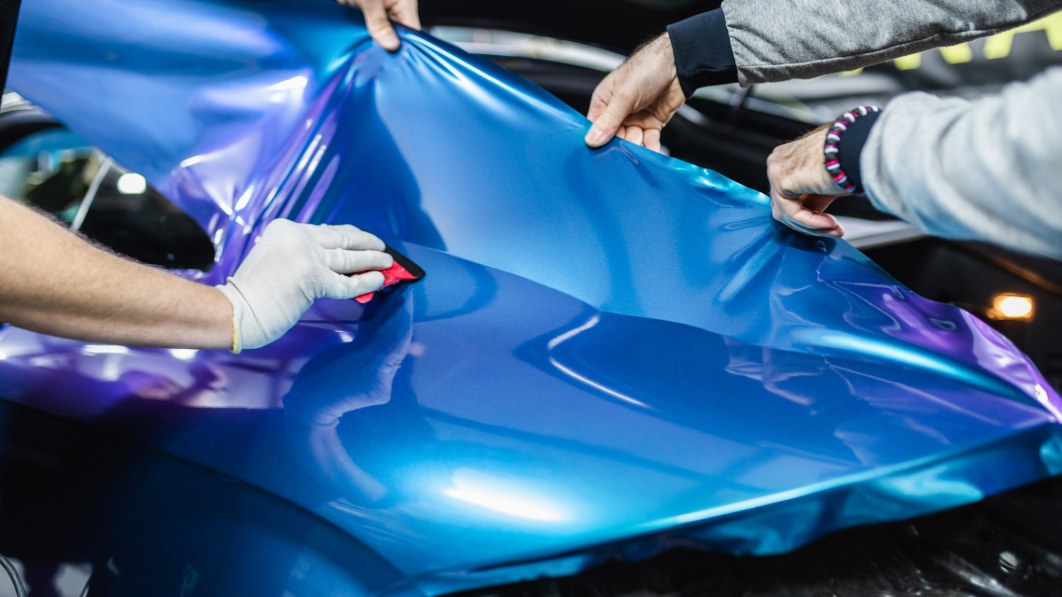America’s favorite car colors skew toward the boring, with white, gray, and black holding the top three spots. That can be a real bummer if you’re shopping for a used car and want something spicier, but the good news is that you can easily get more color in your life with a vinyl wrap.
Wrapping a car involves using sheets of vinyl material with an adhesive to bond them to the paint. Modern wraps are less expensive than a paint job from a reputable shop, last for years, and won’t give you a hernia if you decide to change things up. They also come in wild colors not typically offered by mainstream automakers and can be customized with patterns or graphics if you use your vehicle for business purposes. However, like paint jobs, wraps come in a range of quality and cost options, so you’ll need to think about your needs and budget before diving in.
What does a wrap cost?
The cost of a wrap job depends on several factors, including the color, finish (matte, gloss, metallic), and the size of the vehicle. Small cars, such as a Volkswagen Golf GTI, cost around $3,000 to wrap, while a Ford Expedition could cost $4,000 or more. Opting for a color-shifting finish or a complex patterned wrap could double those costs for some vehicles, and you’ll pay more for a complete wrap job that includes the engine bay and door jambs.
Though they take more attention and care than traditional auto paint, wraps offer protection against the elements and can extend the life of a factory paint job, even if you’re really in it for the color. Just keep in mind that leaving it on longer than recommended might make it harder to remove and more likely to damage the paint underneath. A wrap can also be a great way to cover fading paint as a cheaper option than getting a new paint job, but consider that it’s only a temporary fix, and you’ll need to disclose the wrap and paint condition if you decide to sell the car.
How long does it take to wrap a car?
In general, expect a one- to two-day job if you take your vehicle to a professional shop for a wrap, though the work times could vary depending on the size of the vehicle and type of wrap. Doing the work on your own can take much longer, especially if you’re inexperienced or want to wrap out-of-the-way areas such as the door jambs and under-hood components. If a DIY job is in your future, make sure to give yourself time to make mistakes. While some parts are forgiving, wrapping is a finicky job that takes patience many of us lack. Wrinkles, bubbles, and misaligned panel pieces are all part of the job, so you’ll want to plan a little extra time to curse and figure things out.
How long do car wraps last?
High-quality wraps can last between five to seven years, though the type of wrap material and finish can affect that timeline. Home wrap jobs may fall a little short of that benchmark, as you might not have access to the same materials or adhesives, and home work environments tend not to be as clean (dust, open air, etc.), which can complicate the wrap job and affect durability. And keep in mind that keeping a wrap on the car longer than recommended can create problems when it comes time to remove it.
Which parts of a car get wrapped?
You have a few choices to make here, as you can opt for the simplest wrap job possible and omit the more hidden areas, such as door jambs. If you go this route, you’ll have to live with seeing the old color every time you open the doors, hood, or trunk. On the flip side, wrapping the harder-to-reach areas can cost more and take more time to complete, but you’ll have a more desirable and attractive end result if you go for the gusto. A simple wrap might be OK for a weekend racer or quick project-car paint cover-up, but you’ll want to spend the time or money to have a more complete job if you plan to keep the car or display it after the wrap.
Is it cheaper to paint or wrap a car?
You get what you pay for, but a super basic paint job can be had for as little as $500. Now, getting out for that cheap may make your aging paint look a little better, but you will likely only get a quick spray that won’t stand the test of time. Shops that offer these jobs do the bare minimum on the cheapest paint possible, so you might need another spray before you know it. Higher-quality paint jobs can cost $1,500 or more, depending on your vehicle, and getting anything that resembles some of today’s more elaborate wrap jobs will cost thousands.
Professional wrap jobs can cost about the same as a decent paint job, but you’re not committing to a color long-term. This would be a good option if your car’s paint isn’t in terrible shape or if you want a unique color or pattern. If you’re the DIY sort, you can come out spending a lot less money, but consider the quality and longevity of your work.
Finally, paying a shop to remove a wrap can cost $500 or more, so factor that into your budget if you want to go that route.
Downsides to vinyl wrapping your car
Wraps look great and can bring a quick pop of color or a unique pattern to your car, but they’re not always the best choice. You’ll need to consider the downsides of a vinyl wrap, which can be significant, depending on where you live and how you use your vehicle. Vinyl requires attention and care, and you can’t park for too long in direct sun or extremely hot areas.
You’ll need to clean the surface regularly, especially if you see bird droppings, bugs, or salt/sand — but automatic or touchless car washes are a big no-no, and you can’t use a harsh abrasive cleaner. While wraps look and feel like regular paint, you should treat them like a sticker, which they are. The hassle might outweigh any benefits you get.




























